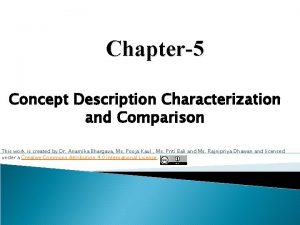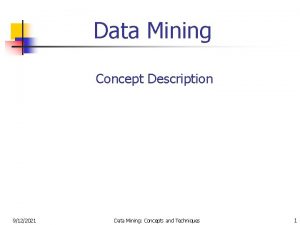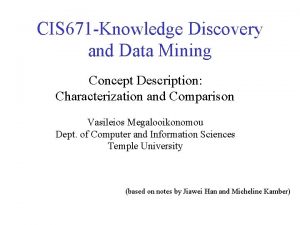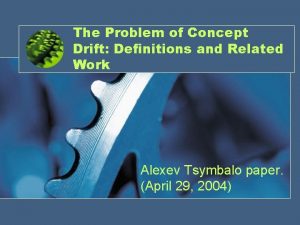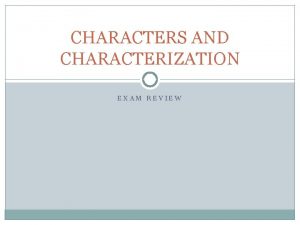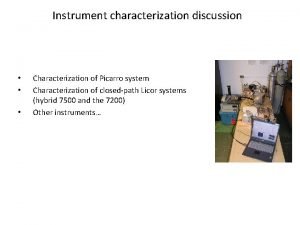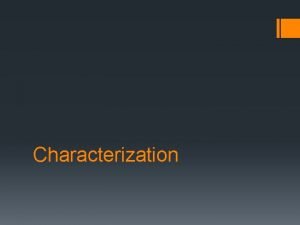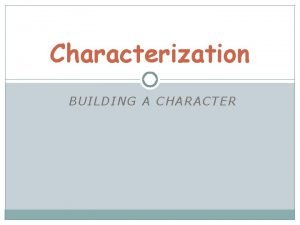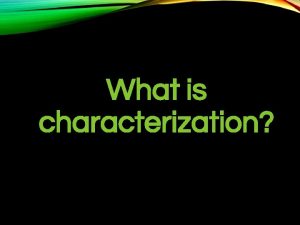Chapter5 Concept Description Characterization and Comparison This work











- Slides: 11

Chapter-5 Concept Description Characterization and Comparison This work is created by Dr. Anamika Bhargava, Ms. Pooja Kaul , Ms. Priti Bali and Ms. Rajnipriya Dhawan and licensed under a Creative Commons Attribution 4. 0 International License.

Data mining can be classified into two categories: Descriptive data mining Predictive data mining. The descriptive describes the data set in a concise and summarized manner and presents interesting general properties of the data. The predictive constructs a set of models, by performing certain analysis on the available set of data, and attempts to predict the behavior of new data sets. 2

What is concept description? A concept usually refers to a collection of data such as frequent buyers, graduate students, and so on. Concept description generates descriptions for characterization and comparison of the data. Characterization provides a concise and summarization of the given collection of data, while class comparison provides descriptions comparing two or more collections of data. Since concept description involves both characterization and comparison. 3

Differences between concept description in OLTP &OLAP Data warehouses and OLAP tools are based on a multidimensional data model which views data in the form of a data cube, consisting of attributes and measures (aggregate functions). However, the data types of the dimensions and measures are restricted. Many current OLAP systems confine dimensions to nonnumeric data. Similarly, measures as count(), sum(), average()) in current OLAP systems apply only to numeric data. 4

User control versus automation On-line analytical processing in data warehouses is a purely user-controlled process. The selection of dimensions and the application of OLAP operations, such as drill-down, roll-up, dicing, and slicing, are directed and controlled by the users. Although the control in most OLAP systems is quite user-friendly, users do require a good understanding of the role of each dimension. Furthermore, in order to find a satisfactory description of the data, users may need to specify a long sequence of OLAP operations. 5

Data generalization and summarizationbased characterization The item relation in a sales database may contain attributes describing low level item information such as item ID, name, brand, category, supplier, place made, and price. It is useful to summarize a large set of data and present it at a high conceptual level. Summarizing a large set of items relating to season sales provides a general description of such data, which can be very helpful for sales and marketing managers. Data generalization is a process which abstracts a large set of task-relevant data in a database from a relatively low conceptual level to higher conceptual levels. Two Methods are (1) the data cube approach (2) the attribute-oriented 6

The data cube approach can be considered as a data warehouse-based, pre-computation-oriented, materialized view approach. It performs off-line aggregation before an OLAP or data mining query is submitted for processing. The attribute-oriented approach, at least in its initial proposal, is a relational database queryoriented, generalization-based, on-line data analysis technique. 7

1. Attribute removal is based on the following rule Ifthereisalargesetofdistinctvaluesforanattributeof the initial working relation: (1) There is no generalization operator on the attribute (e. g. , there is no concept hierarchy defined for the attribute). (2) attributes, then the attribute should be removed from the working relation. 8

2. Attribute generalization is based on the following rule: If there is a large set of distinct values for an attribute in the initial working relation, and there exists a set of generalization operators on the attribute, then a generalization operator should be selected and applied to the attribute. Both rules, attribute removal and attribute generalization, claim that if there is a large set of distinct values for an attribute, further generalization should be applied. This raises the question: how large is “a large set of distinct values for an attribute" considered to be? 9

Two common approaches to control a generalization process The First technique, called attribute generalization threshold control, either sets one generalization threshold for all of the attributes, or sets one threshold for each attribute. If the number of distinct values in an attribute is greater than the attribute threshold, further attribute removal or attribute generalization should be performed. The second technique, called generalized relation threshold control, sets a threshold for the generalized relation. If the number of (distinct) tuples in the generalized relation is greater than the threshold, further generalization should be performed. Otherwise, no further generalization should be performed. Such a threshold may also be preset in the data mining system (usually within a range of 10 to 30) 10

Thank you 11
 Characterization and comparison in data mining
Characterization and comparison in data mining Limit comparision test
Limit comparision test Direct vs indirect characterization
Direct vs indirect characterization Indirect characterization
Indirect characterization Formal definition examples
Formal definition examples Concept description in data mining
Concept description in data mining What is concept description in data mining
What is concept description in data mining Chapter 4 work and energy section 1 work and machines
Chapter 4 work and energy section 1 work and machines The problem of concept drift: definitions and related work
The problem of concept drift: definitions and related work Ideal self explanation
Ideal self explanation Pengertian marketing concept
Pengertian marketing concept Smart work and hard work
Smart work and hard work
